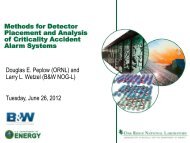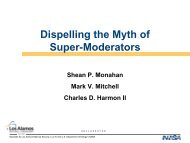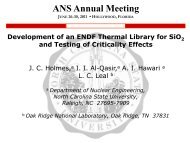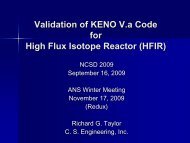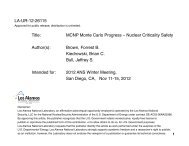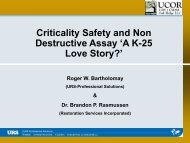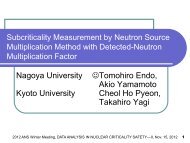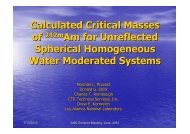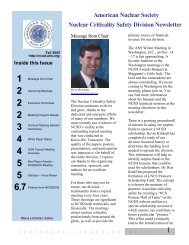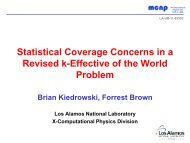Small-angle Compton Scattering to Determine the Attenuation of ...
Small-angle Compton Scattering to Determine the Attenuation of ...
Small-angle Compton Scattering to Determine the Attenuation of ...
You also want an ePaper? Increase the reach of your titles
YUMPU automatically turns print PDFs into web optimized ePapers that Google loves.
2011 ANS Winter Meeting in Washing<strong>to</strong>n, D.C. Oc<strong>to</strong>ber 30 – November 3, 2011<br />
<strong>Small</strong>-<strong>angle</strong> <strong>Comp<strong>to</strong>n</strong> <strong>Scattering</strong> <strong>to</strong><br />
<strong>Determine</strong> <strong>the</strong> <strong>Attenuation</strong> <strong>of</strong> Gamma Rays<br />
from HEU<br />
Rick B. Oberer<br />
Cynthia A. Gunn<br />
Lisa G. Chiang<br />
Michael C. Mattmann
Disclaimer<br />
This report was prepared as an account <strong>of</strong> work sponsored by an agency <strong>of</strong><br />
<strong>the</strong> United States Government. Nei<strong>the</strong>r <strong>the</strong> United States Government nor<br />
any agency <strong>the</strong>re<strong>of</strong>, nor any <strong>of</strong> <strong>the</strong>ir employees, makes any warranty,<br />
express or implied, or assumes any legal liability or responsibility for <strong>the</strong><br />
accuracy, completeness, or usefulness <strong>of</strong> any information, apparatus,<br />
product, or process disclosed, or represents that its use would not infringe<br />
privately owned rights. Reference herein <strong>to</strong> any specific commercial<br />
product, process, or service by trade name, trademark, manufacturer, or<br />
o<strong>the</strong>rwise, does not necessarily constitute or imply its endorsement,<br />
recommendation, or favoring by <strong>the</strong> United States Government or any<br />
agency <strong>the</strong>re<strong>of</strong>. The views and opinions <strong>of</strong> authors expressed herein do not<br />
necessarily state or reflect those <strong>of</strong> <strong>the</strong> United States Government or any<br />
agency <strong>the</strong>re<strong>of</strong>.
Acknowledgement:<br />
Rick .B. Oberer<br />
Cynthia A. Gunn<br />
Lisa G. Chiang<br />
Robert E. Valiga<br />
Julia A. Cantrell<br />
Funded by Nuclear Safety Research and Development<br />
(NSRD)
Gamma Non Destructive Analysis<br />
• Gamma NDA measurements are dependant on:<br />
– Geometry<br />
• Distance <strong>of</strong> source <strong>to</strong> detec<strong>to</strong>r<br />
• Physical Dimensions (containers, measurement distance)<br />
– <strong>Attenuation</strong><br />
• Process Knowledge (matrix composition, bulk density, net<br />
weight)<br />
• Matricies (material interfering with gamma rays <strong>of</strong><br />
interest)<br />
• Material Forms<br />
• Self-Shielding <strong>of</strong> material<br />
• Many <strong>of</strong> <strong>the</strong>se can be <strong>the</strong>oretically estimated or calculated<br />
• At Y-12 gamma emitting radiation is present in a variety <strong>of</strong><br />
forms and myriad locations<br />
• Departure from reliance on ‘representative standards’<br />
– Development <strong>of</strong> Theoretical corrections, such as <strong>the</strong> use <strong>of</strong><br />
<strong>Small</strong> Angle <strong>Comp<strong>to</strong>n</strong> <strong>Scattering</strong>
Nuclear criticality issue<br />
• HEU Chemical Processing Floors<br />
– At Y-12, HEU solution has been spilled and absorbed in<strong>to</strong><br />
<strong>the</strong> concrete floors <strong>of</strong> chemical processing areas.<br />
– The amount <strong>of</strong> HEU estimated by NDA is significant.<br />
– The estimated quantity is highly dependent on <strong>the</strong> depth<br />
distribution <strong>of</strong> <strong>the</strong> HEU in <strong>the</strong> floor.
Quantifying Radioactivity and <strong>Attenuation</strong><br />
To quantify <strong>the</strong> amount <strong>of</strong> radioactivity, need <strong>to</strong> know<br />
• geometry and<br />
• amount <strong>of</strong> attenuation <strong>of</strong> gamma rays.<br />
– Differential <strong>Attenuation</strong><br />
• For HEU, use <strong>of</strong> U-235 gamma rays<br />
– (144keV, 168keV, 186keV, and 205keV)<br />
• Can also use higher energy gamma rays from Tl-208 from U-232 in HEU *<br />
– (277keV, 511keV, 583keV, 860keV, 2614keV)<br />
*<br />
Y-12 innovation. R. B. Oberer, L. G. Chiang, M. J. Norris, C. A. Gunn, B. C. Adaline, "The use <strong>of</strong> Tl-208<br />
gamma rays for safeguards, nondestructive-assay (NDA) measurements," INMM Central Regional Chapter,<br />
2009 Fall Meeting, Oak Ridge, Tennessee, November 3-4, 2009, Y/EN-8270 May 26, 2009.<br />
http://www1.y12.doe.gov/search/library/documents/pdf/yen-8270.pdf
Differential attenuation<br />
Uncorrected<br />
Corrected
<strong>Small</strong>-<strong>angle</strong> <strong>Comp<strong>to</strong>n</strong> scattering discontinuity
Experimental setup<br />
HEU solution absorbed on paper between Hardy board (1-15) and patio<br />
blocks (16, 17).<br />
Monte Carlo U-235 planar source at a<br />
discrete depth,<br />
Monte Carlo U-235 planar source at a<br />
continuous distribution <strong>to</strong> depth,
Count rate (cps)<br />
Count rate<br />
Gamma Ray <strong>Attenuation</strong><br />
N<br />
<br />
<br />
x N 0<br />
Experimental<br />
e<br />
x<br />
Monte Carlo<br />
120<br />
7.E-06<br />
100<br />
y = 155.75e -0.126x<br />
R² = 0.9993<br />
6.E-06<br />
y = 6E-06e -0.328x<br />
80<br />
5.E-06<br />
60<br />
4.E-06<br />
3.E-06<br />
40<br />
2.E-06<br />
20<br />
1.E-06<br />
0<br />
0 10 20 30 40<br />
Density thickness (ρx) concrete (g/cm2)<br />
0.E+00<br />
0 2 4 6 8 10 12<br />
Concrete depth x (cm)
<strong>Small</strong>-<strong>angle</strong> <strong>Comp<strong>to</strong>n</strong> scattering is calculated from <strong>the</strong><br />
spectrum as follows:<br />
N sa<br />
x<br />
ROI<br />
<br />
E<br />
ROI<br />
1 2
Klein-Nishina (for computing fraction <strong>of</strong> interactions that<br />
are small <strong>angle</strong> <strong>Comp<strong>to</strong>n</strong> scatters, k)<br />
k<br />
d<br />
dE<br />
<br />
0<br />
The differential cross-section for θ = 0<br />
depends only on <strong>the</strong> a<strong>to</strong>mic-number Z <strong>of</strong> <strong>the</strong><br />
material and <strong>the</strong> energy Eγ <strong>of</strong> <strong>the</strong> gamma ray.<br />
The <strong>to</strong>tal cross-section σ taken from<br />
XCOM [1] data.<br />
d<br />
dE<br />
0<br />
<br />
254.9<br />
<br />
Z<br />
<br />
keV<br />
b<br />
2<br />
E<br />
<br />
Berger, M.J., Hubbell, J.H., Seltzer, S.M., Chang, J., Coursey, J.S.,<br />
Sukumar, R., Zucker, D.S., and Olsen, K. (2010), XCOM: Pho<strong>to</strong>n<br />
Cross Section Database (version 1.5). National Institute <strong>of</strong> Standards<br />
and Technology, Gai<strong>the</strong>rsburg, MD.<br />
http://physics.nist.gov/xcom
Count rate (cps/keV)<br />
Count rate<br />
<strong>Small</strong>-<strong>angle</strong> count rate for discrete case<br />
N<br />
sa<br />
x<br />
x<br />
kN0xe<br />
<br />
Experimental<br />
1.2<br />
Monte Carlo<br />
4.E-08<br />
1<br />
3.E-08<br />
0.8<br />
3.E-08<br />
0.6<br />
2.E-08<br />
0.4<br />
2.E-08<br />
0.2<br />
1.E-08<br />
5.E-09<br />
0<br />
0 10 20 30 40<br />
0.E+00<br />
0 5 10 15<br />
Density thickness (ρx) concrete (g/cm 2 )<br />
Concrete depth x (cm)
A linear relationship<br />
For a radioactive source at a discrete depth x, <strong>the</strong> ratio <strong>of</strong> <strong>the</strong> small-<strong>angle</strong> <strong>Comp<strong>to</strong>n</strong><br />
scattering discontinuity <strong>to</strong> <strong>the</strong> peak is linear and directly proportional <strong>to</strong> <strong>the</strong> product (μρx)<br />
Primary gamma<br />
rays<br />
<strong>Small</strong> <strong>angle</strong> scattered gamma<br />
rays<br />
N<br />
N<br />
<br />
sa<br />
x<br />
x<br />
N 0<br />
e<br />
x<br />
x<br />
kN0xe<br />
<br />
Ratio<br />
N sa<br />
N<br />
<br />
x<br />
x<br />
<br />
kx
Step/Peak<br />
Step/Peak<br />
Discrete Depth (x)<br />
Experimental<br />
N sa<br />
N<br />
<br />
x<br />
x<br />
<br />
kx<br />
Monte Carlo<br />
0.08<br />
5.0E-02<br />
0.07<br />
4.5E-02<br />
0.06<br />
4.0E-02<br />
0.05<br />
3.5E-02<br />
3.0E-02<br />
0.04<br />
2.5E-02<br />
0.03<br />
2.0E-02<br />
0.02<br />
0.01<br />
1.5E-02<br />
1.0E-02<br />
5.0E-03<br />
0.00<br />
0 10 20 30 40<br />
0.0E+00<br />
0 5 10 15<br />
Density thickness (ρx) concrete (g/cm2)<br />
Concrete depth x (cm)
Step/Peak<br />
Continuous distribution (x)<br />
Step/Peak<br />
N<br />
N<br />
sa<br />
<br />
x<br />
x<br />
<br />
<br />
x<br />
k 1<br />
e<br />
1<br />
e<br />
<br />
<br />
1<br />
x<br />
x<br />
<br />
<br />
<br />
Experimental<br />
0.14<br />
0.12<br />
0.10<br />
0.08<br />
Monte Carlo<br />
0.014<br />
0.012<br />
0.010<br />
0.008<br />
0.06<br />
0.006<br />
0.04<br />
0.004<br />
0.02<br />
0.002<br />
0.00<br />
0 10 20 30 40<br />
0.000<br />
0 2 4 6 8 10 12<br />
Density thickness concrete (g/cm 2 )<br />
Concrete depth x (cm)
Measurement results with and without small <strong>angle</strong><br />
Spreadsheet<br />
Actual depth<br />
Actual Areal Density = 0.085 gU235/cm 2<br />
Spreadsheet<br />
Assumed 4" depth<br />
ISOTOPIC<br />
Assumed 4" depth<br />
<strong>Small</strong><br />
Angle<br />
Case 1 0.072 0.096 0.129 0.079<br />
Case 2 0.084 0.103 0.121 0.089<br />
Case 3 0.083 0.086 0.107 0.087<br />
Case 8 0.085 0.085 0.077 0.082<br />
Average: 0.081 0.092 0.108 0.084<br />
Standard deviation: 0.006 0.009 0.023 0.004<br />
Actual Areal Density = 0.052 gU235/cm 2<br />
Case 4 0.052 0.070 0.070 0.051<br />
Case 5 0.045 0.052 0.069 0.050<br />
Case 6 0.048 0.052 0.065 0.052<br />
Case 7 0.051 0.054 0.065 0.046<br />
Case 9 0.040 0.045 0.041 0.054<br />
Average: 0.047 0.055 0.062 0.050<br />
Standard deviation: 0.005 0.009 0.012 0.003
Measured areal density (gU235/cm2)<br />
Measurement results with and without small <strong>angle</strong><br />
0.15<br />
0.13<br />
ISOTOPIC<br />
<strong>Small</strong> <strong>angle</strong><br />
Spreadsheet<br />
0.11<br />
0.09<br />
0.07<br />
0.05<br />
0.03<br />
0.03 0.04 0.05 0.06 0.07 0.08 0.09<br />
True areal density (gU235/cm2)
Summary <strong>of</strong> equations<br />
The small-<strong>angle</strong> <strong>Comp<strong>to</strong>n</strong> scattering differential<br />
cross-section is determined from <strong>the</strong> a<strong>to</strong>micnumber<br />
Z and gamma-ray energy E γ<br />
according <strong>to</strong><br />
d<br />
dE<br />
0<br />
<br />
254.9<br />
<br />
Z<br />
<br />
keV<br />
b<br />
2<br />
E<br />
<br />
Dividing this differential cross-section by <strong>the</strong> <strong>to</strong>tal<br />
cross-section σ gives <strong>the</strong> fraction k <strong>of</strong> interactions<br />
which are small-<strong>angle</strong> <strong>Comp<strong>to</strong>n</strong> scatters<br />
Multiplying this fraction k by <strong>the</strong> mass-attenuation<br />
coefficient μ density ρ and depth x <strong>of</strong> a discrete<br />
gamma-ray source gives <strong>the</strong> magnitude <strong>of</strong> small<strong>angle</strong><br />
scattering discontinuity divided by <strong>the</strong> peak<br />
height<br />
k<br />
d<br />
dE<br />
<br />
N sa<br />
N<br />
<br />
x<br />
x<br />
0<br />
kx<br />
A continuous, uniform distribution in a matrix<br />
<strong>to</strong> a depth x is given from <strong>the</strong> same variables<br />
(μρx)<br />
N<br />
N<br />
sa<br />
<br />
x<br />
x<br />
<br />
<br />
x<br />
k 1<br />
e 1<br />
x<br />
x<br />
1<br />
e<br />
<br />
<br />
<br />
<br />
<br />
*<br />
R.B. Oberer, C.A. Gunn, L.G. Chiang, R.E. Valiga, J.A. Cantrell, "<strong>Small</strong>-<strong>angle</strong> <strong>Comp<strong>to</strong>n</strong><br />
<strong>Scattering</strong> <strong>to</strong> <strong>Determine</strong> <strong>the</strong> Depth <strong>of</strong> a Radioactive Source in Matter," Technical Report RP<br />
900000-0006, Y-12 National Security Complex, April 2011.<br />
http://www1.y12.doe.gov/search/library/documents/pdf/RP-900000-0006.pdf
Conclusion<br />
• The small-<strong>angle</strong> <strong>Comp<strong>to</strong>n</strong>-scattering discontinuity can be<br />
used <strong>to</strong> determine <strong>the</strong> amount <strong>of</strong> intervening matter<br />
between a gamma-ray source and detec<strong>to</strong>r.<br />
• It can be used in addition <strong>to</strong> differential attenuation, or<br />
• when differential attenuation cannot be used such as a<br />
single gamma ray source such as Cs-137.<br />
• This depth is useful in estimating <strong>the</strong> attenuation <strong>of</strong> <strong>the</strong><br />
gamma rays




